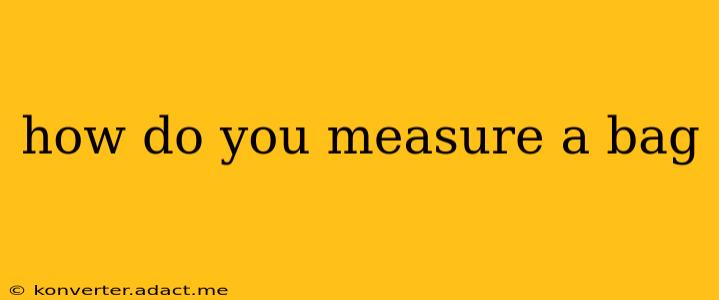Measuring a bag accurately is crucial for various reasons – from ensuring it fits your needs and desired items to comparing sizes online or in stores, and even for shipping purposes. But how do you do it correctly? This guide will cover various methods and considerations to ensure you get precise measurements every time.
What Tools Do I Need to Measure a Bag?
Before you begin, gather the necessary tools. You’ll primarily need a flexible measuring tape, but a ruler can also be helpful for smaller bags or more precise measurements of specific features. A pen and paper (or a digital note-taking app) are handy for recording your findings.
How to Measure the Dimensions of a Bag: A Step-by-Step Guide
Most bags are described using three key dimensions:
- Height: This is the vertical measurement of the bag, typically taken from the base to the top, excluding any handles or straps.
- Width: This is the horizontal measurement at the widest point of the bag.
- Depth: This is the measurement from the front to the back of the bag at its widest point.
Here's a step-by-step guide:
-
Lay the bag flat: Place the bag on a flat, level surface. Ensure it's not crumpled or distorted.
-
Measure the height: Extend the measuring tape from the base of the bag to its highest point, excluding handles or straps. Record this measurement.
-
Measure the width: Find the widest part of the bag and measure across it horizontally. Record this measurement.
-
Measure the depth: Measure the distance from the front of the bag to the back at the widest point. Record this measurement.
-
Additional Measurements: Consider taking additional measurements for specific features, such as:
- Handle Drop: The distance from the top of the bag to the bottom of the handle.
- Strap Length: If applicable, measure the length of the shoulder strap or crossbody strap.
- Pocket Dimensions: Measure the interior or exterior pockets if relevant.
Remember to always measure in the same units (inches or centimeters) throughout the process to maintain consistency.
What Are the Standard Units for Measuring Bags?
While both inches and centimeters are commonly used, consistency is key. When comparing bag sizes online, pay close attention to the units used in the product description. If you're shopping internationally, be aware that different regions may prefer one unit over the other.
How to Measure a Backpack?
Measuring a backpack is similar to measuring other bags, but you should consider adding measurements for the:
- Waist Strap Length: If the backpack has a waist strap, measure its length.
- Chest Strap Length: Similarly, measure the chest strap if present.
- Compartment Sizes: Measure the main compartment and any smaller pockets for a more comprehensive overview.
How Do I Measure an Irregularly Shaped Bag?
For bags with unusual shapes, you may need to take multiple measurements at different points to get a better representation of its size. Clearly describe the measurements and their corresponding locations in your notes. Photographs can also be helpful for irregular shapes.
Why is Measuring a Bag Important?
Accurate bag measurements are essential for several reasons:
- Ensuring proper fit: Knowing the dimensions helps determine if the bag will comfortably fit your belongings and meet your needs.
- Online shopping: Online retailers often list bag dimensions; accurate measurements are crucial for accurate comparisons and avoiding returns.
- Travel: Baggage size restrictions for airlines and other transportation methods rely on precise measurements.
- Storage: Understanding the size of your bag is essential for determining suitable storage space.
By following these steps and taking detailed measurements, you can accurately assess the size of any bag and make informed decisions about purchasing or using it.
